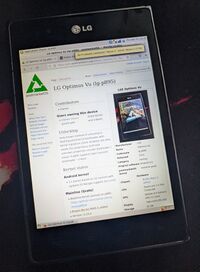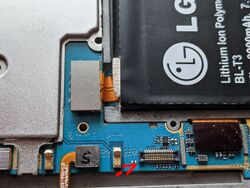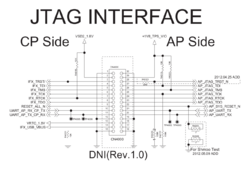LG Optimus Vu (lg-p895): Difference between revisions
No edit summary |
|||
| Line 34: | Line 34: | ||
| status_sms = | | status_sms = | ||
| status_calls = | | status_calls = | ||
| status_otg = | | status_otg = P | ||
| status_usba = - | | status_usba = - | ||
| status_hdmidp = | | status_hdmidp = | ||
| Line 122: | Line 122: | ||
| P | | P | ||
| USB | | USB | ||
| Peripheral is fully functional. Needs additional configurations for more power saving mode ( | | Peripheral is fully functional. Needs additional configurations for more power saving mode (USB requires one of pmic regulators to be always on). OTG currently can work only via OTG-Y cable and USB line has to be in host mode. | ||
|- | |- | ||
| Y | | Y | ||
Revision as of 07:21, 28 September 2022
 Optimus Vu in recursion | |
| Manufacturer | LGE |
|---|---|
| Name | Optimus Vu |
| Codename | lg-p895 |
| Released | 2012 |
| Hardware | |
| Chipset | Nvidia Tegra 3 (AP33) |
| CPU | Quad-core 1.5 GHz Cortex-A9 |
| GPU | NVIDIA ULP GeForce GPU 12 cores |
| Display | 768×1024 IPS LCD |
| Storage | 32 GB |
| Memory | 1 GB |
| Architecture | armv7 |
| Software | |
| Original software | Android 4.0 |
| FOSS bootloader | yes |
| postmarketOS | |
| Category | testing |
| Pre-built images | no |
| Mainline | yes |
| postmarketOS kernel | mainline grate |
| Unixbench Whet/Dhry score | 1079.2 |
| Primary Bootloader |
Works |
|---|---|
| Secondary Bootloader |
Partial |
| Mainline |
Works |
| Internal Storage |
Works |
| USB Peripheral |
Works |
| Display |
Works |
| Buttons |
Works |
| This device is based on the Tegra 3. See the SoC page for common tips, guides and troubleshooting steps |
Contributors
- Clamor
Users owning this device
- Clamor (Notes: pmOS with Grate kernel and U-Boot)
Unlocking
Only known method of unlocking is flashing patched LG bootloader with kernel signature check disabled, but who needs this proprietary stuff with unknown properties (vendor bootloader I mean) if p895 supports open sourced bootloader - U-Boot.
Kernel status
Android kernel
- 3.1 kernel based on LG sources with updates till Nougat support (Kernel)
Mainline (Grate)
- Baseline kernel sources on p895: https://github.com/clamor-s/linux/tree/p895
- Proper dts for P895 is added
- Version: 5.19.0
- Status: Boots. Panel support added.
Installation
Will be filled later
Hardware status (mainline)
| Status | Hardware | Info |
|---|---|---|
| Y | Booting | Android style boot.img has restriction of approx 4 MB, which is fraction of /boot partition size. |
| Y | Bootloader | Open source bootloader U-Boot is available as alternative for stock LG bootloader and can replace it. U-Boot can not boot downstream kernel if it has Trusted Foundations enabled. |
| Y | Panel | KOE/Hitachi TX13D100VM0EAA MIPI DSI LCD IPS panel via Solomon SSD2825 DSI/LVDS bridge. |
| Y | Backlight | TI LM3533 led controlled is used for main backlight. Driver is converted into OF but can not be requested by panel. |
| N | HDMI output | Device supports MHL via SII9244 hdmi bridge on it own i2c-gpio line. Currently not configured. Is similar to SII9234 driver but is not same, requires hw setup look. |
| Y | Touchscreen | Synaptics RMI4 S3203B touchscreen is used. |
| N | Touch buttons | Synaptics RMI4 S3204B touchscreen's function 3/19/1a/30, not clear which is used. |
| P | USB | Peripheral is fully functional. Needs additional configurations for more power saving mode (USB requires one of pmic regulators to be always on). OTG currently can work only via OTG-Y cable and USB line has to be in host mode. |
| Y | Internal memory | eMMC 32 Gb by Hynix model HBG4e. Missing OPPs for 266,5 MHz. |
| N | GPS | Some fancy GSD5T GNSS module. |
| Y | WiFi | Uses Azurewave AW-NH665 BCM4330B1. Wi-Fi should work out of the box. All needed stuff is included. |
| P | Bluetooth | BCM4330B1 37.4 MHz Class 1.5 W-ExtLNA PCM-S. Perfectly fine is detected by kernel, recognized by userspace but once enabled, userspace part dissapears without logs. Blocking it in rfkill restores bt state. Needs investigations. |
| Y | NFC | As on most devices of this age PN544 is used. Recognizes NFC tags. |
| Y | GPIO keys/switches | There are 3 GPIO keys: Power, Volume up, Volume down. Memo key though is a gpio based refuses to work on mainline. |
| Y | GPIO leds | There are 2 GPIO leds: Power button led and Keypad led. Bound and work via sysfs, will be linked to co-responding drivers. |
| N | Vibro | isa1200 haptic engine. Available VIP driver does not work. |
| Y | Battery | MAX17040 fuel gauge is used. Fully set up. |
| P | Charger | Seems to be hw preconfigured and can charge device even in turned off state. Maxim MAX8971 charger is used. |
| P | Extcon | Maxim MAX14526 MUIC is used. Driver prototype is available. |
| Y | PMIC | Optimus Vu uses Maxim MAX77663 PMIC mfd. Media devices have own sub-PMIC TI LP8720. |
| Y | Sound | Sound codec is Maxim MAX98089. Fully routed in kernel, UCM's are complete for media and calls. Audio via HDMI should work out of the box. |
| Y | Thermal sensor | NCT1008 ON Semiconductor LM90 series thermometer and Tegra T sensor. Both work perfectly fine. |
| Y | Power sensor | Ina230 works fine. Battery has its own tsc2007 ADC to detect battery temperature, works as current sensor. |
| Y | Orientation sensors | Include mpu6050 imu (accelerometer, gyroscope and thermometer) and ami306 compass. |
| P | Light and Proximity sensor | APDS990X - combined AL and proximity sensor is used. OF conveted done, needs iio conversion. |
| N | Front camera | Sony 1.3 MP imx119 sensor. |
| N | Rear camera | Sony 8 MP imx111 sensor with DW9714 lens voice coil and LM3560 flash led. |
| N | Modem | Intel XMM6260 modem is used on usb2 line in hsic mode. |
| P | ULP GeForce | GPU Acceleration partially works. |
Usability
Desktop environment
Since 3D acceleration is not available yet, all DE which use it will be painfully slow and laggy.
Currently xfce4 or mate are recommended.
U-Boot
Current U-Boot status on LG Optimus Vu
| Status | Feature | Info |
|---|---|---|
| Y | Primary bootloader | U-Boot successfully boots when is flashed into EBT partition instead of LG bootloader. Can be additionally booted via fusée gelée exploit. |
| P | Secondary bootloader | U-Boot can be chainloaded from both /boot and /recovery partitions, though LG bootloader has some conflicts with U-Boot. |
| Y | Panel | Solomon SSD2825 bridge, Hitachi KOE TX13D100VM0EAA DSI panel, TI lm3533 backlight were all added into U-Boot. Panel is fully functional. |
| Y | eMMC | Mostly functional and detectable. Can be used as boot source. |
| Y | Boot kernel | Yes, and can be highly adjusted. Default kernel and dtb are booted from 4th partition of eMMC (/cache) and /root is on 8th partition (/data). Both partitions can be mounted in bootmenu. Kernel name must be vmlinuz, dtb - tegra30-lge-p895.dtb, ramdisk is optional, name is uInitrd and it must be in u-boot format. |
| Y | Boot menu | Native u-boot bootmenu works perfectly fine. It can be called with pressing volume down button on boot. |
| Y | Power management | Offline charging and charging in u-boot both work and are hw configured. Both power off and reboot options work and are available in bootmenu. If no valid kernel is found phone will turn off. |
| P | Fastboot | Fastboot option is available in bootmenu. All functions but flash/erase/reboot-bootloader operate correctly. |
| N | Boot from script | NA yet |
| P | Boot Android | Booting both Android kernel (LNX) and Recovery (SOS) are implemented. Legacy kernel requires Trusted Zone, which is not supported by u-boot. FIX ME!
Although if legacy kernel does not have CONFIG_TRUSTED_FOUNDATIONS = y and some additional small patches, it can be booted by u-boot. |
| Y | Self update | Self update option is implemented and write is done correctly. Bootloader file has to have name u-boot-dtb-tegra.bin and be placed on 4th partition of eMMC (/cache). |
Gallery
Serial console


LG Optimus Vu is an interesting device since it has factory soldered jtag directly on motherboard in pretty apposite and easily accessible place. To get to jtag you need only to take off back cover and plastic casing over motherboard. That is it, only one free socket is jtag. UART is UART-D (serial@70006300; 115200n8) and uses 3.3v.
See also
- More about the device Wikipedia entry




